The archaeological garden provides a glimpse into the history of Jerusalem through the ages by displaying some archaeological evidence. The nature of the city and its importance forever fluctuate according to political, social and religious conditions. Many traditions have been associated with Jerusalem, but its sanctity creates its unique status.
The exhibition consists of six sections covering the Second Temple Period through to the Ottoman Period. The artifacts shed light on a variety of issues. The architectural finds illustrate the monumental building activity in Jerusalem, part of which is also documented in written sources. These tell the story of the ancient buildings which are an integral part of the city's fabric today. All the objects were uncovered in archaeological surveys and excavations conducted since the 19th century.
The Israel Antiquities Authority initiated, launched and executed the archaeological garden.

1. The End of the Second Temple Period (63 BCE-70 CE)
"I lay in Zion for a foundation a stone, a tried stone, a costly corner-stone of sure foundation; he that believeth shall not make haste. And I will make justice the line, and righteousness the plummet…"Isaiah 28, 16-17

The Glorious Herodian Buildings
Hundreds of pieces of broken decorated stones were found in the destruction layers surrounding the Temple Mount. These came from the architectural elements (beams, cornices and capitals) of various parts of buildings. Their huge numbers point to the existence of local artisan school that was under influence of the Hellenistic and Roman cultures, yet was characterized by the absence of figurative art. The artistic motifs consisted of geometric and floral patterns.
Origin: The southern vaults of theTemple Mount, under the Huldah Gates.

The Late Roman Period (132-324 CE)
"At Jerusalem Adrian founded a city in place of the one which had been razed to the ground, naming it Aelia Capitolina, and on the site of the temple of the god he raised a new temple to Jupiter. This brought on a war of no slight importance nor of brief duration, for the Jews deemed it intolerable that foreign races should be settled in their city and foreign religious rites planted there." Cassius Dio, Roman History LXIX, 12

A Latin Dedication Inscription
A fragment of a stone slab engraved with a Latin dedication inscription in honor of the Caesars Septimius Severus and his son Septimius Basianus (Caracalla) on the occasion of the completion a building project in 'Aelia Capitolina Commodinana'. The mention of Plautila, Septimius Severus' wife between 202 CE and 205 CE, dates the inscription. The stone table was prepared by the city leadership (the commissioner or the commander of the legion) and its original length was apparently at least 6 m. The stone was used in the pavement of the plaza south of Temple Mount, and like other stones of the Second Temple Period walls and streets, it was in use for generations. At the beginning of the 3rd century CE, the stone was engraved with the memorial inscription. During the later Umayyad Period it was reused for paving.
Origin: The Herodian street south of the Temple Mount.

Nahal Refaim Mosaic
This mosaic floor was found in a 3rd century CE Roman villa. It consisted of two carpets rich in colorful geometric designs. The large carpet was adorned with 'populated scrolls', colored three dimensional meander, a shell (or perhaps a metal bowl), and two fruits that appear to be a pine cone and a fish head (?). The small carpet was decorated with circles created by a guilloch? of rosettes with four leaves.
Origin: The northern bank of Nahal Refaim.

The Byzantine Period (324-638 CE)
"No other sentiment draws people to Jerusalem than the desire to see and touch the places where Christ was physically present, and to be able to say from their own experience, 'We have gone into his tabernacle, and have worshipped in the places where his feet stood.' (Psalms 132: 7)." Paulinus of Nola, Letters 49, 14

A Georgian inscription
An ancient Georgian inscription was found in a crypt of a monastery dated from the end of the 5th century CE or the beginning of the 6th century CE: "This is the grave of Iohane bishop of Purtavi, Kart'veli."
The inscription was dedicated to an unknown priest of Iberian or Georgian origin. The name 'Kart'veli' is the earliest reference to Georgia ever found in archeological sites.
Origin: Umm Leisun, southeast of Jerusalem.
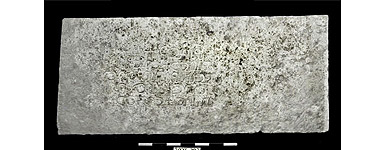
Nahal Qidron Mosaic
This high quality mosaic floor paved the reception hall of a monastery. The surviving section was a panel scattered with medallions and framed with a rope pattern and geometric motifs. Each medallion contained an animal, including a deer and an octopus that were not native to the Jerusalem area. The craftsman was apparently inspired by nature, but the images were borrowed from other regions. This was a 6th-7th centuries CE large monastery, similar to others in the desert fringes.
Origin: Nahal Qidron, west of the Arab el-Sawahara neighborhood.

Mount Scopus Mosaic
The Greek dedication inscription was part of a mosaic floor of a large monastery. The inscription, with its floral decoration, commemorated the monks during whose lifetime the work was executed: "Under Theodorus the Priest and Abbot and Cyriacus the Monk all this work was done."
The monastery was built in the 5th-6th centuries CE and included an inn that served pilgrims and tourists who traveled the Jerusalem-Jericho road during the Byzantine and Early Islamic Periods.
Origin: Eastern slope of Mt. Scopus.
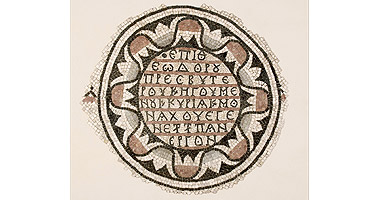
The Islamic Period (638-1516 CE)
"Glory to [Allah] who did take his servant [Muhammad] for a Journey by night from the sacred mosque [in Meca] to the farthest mosque [Al-Aqsa], whose precincts we did bless." Quran, Surah 17, 1

Ayyubid Inscription
The historical sources and the excavations show that the Byzantine fortifications continued to serve the Muslims into the 13th century. Between 1202/3-1212 the governor of Damascus al-Malik al-Muattam intensely rebuilt the city walls. This inscription and another three commemorated his efforts and documented the dates and the people in charge. In 1219, fearing a Crusader attack, he adopted passive defense tactics and began to dismantle the walls. This act weakened security conditions in the city for a long time.
Origin: Near the southwestern corner of the city wall.
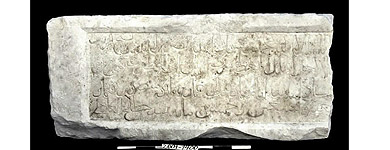
Engraved Wooden Panels
The original panels were carved in the Umayyad Period, 8th century CE. The panels which were not homogenous in their quality, length and thickness, were used to adorn inner parts of buildings: walls, screens, door, balustrade and more. The decorations were engraved in relief. The floral and geometric motifs maintained eastern and western traditions, like other art works of this period. The general composition is uniform, but the different details point to creativity and free artistic expression.
Origin: Al-Aqsa Mosque.
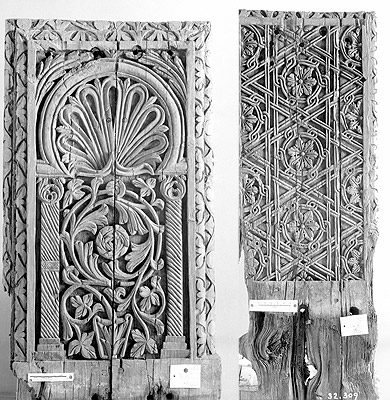
The Umayyad Building Craft
The fragments of cornices adorned with floral motifs illustrate the rich decorations in the Umayyad buildings. The art and architecture of the Early Islamic Period absorbed earlier traditions and created a new repertoire of patterns and abstract harmonic combinations. The excavations south and west of Temple Mount revealed structures that are unmentioned in written sources. These consisted of six large buildings two stories high built along a single street. Two of these were named 'palaces' and they were similar in their plan: an open courtyard surrounded by roofed porticos. These courtyards also included irrigation systems and drainage channels. The style of the buildings, their location and the unique finds discovered there, point to their function as administrative centers. They were destroyed by an earthquake in the middle of the 8th century CE and never rebuilt.
Origin: South of Temple Mount.
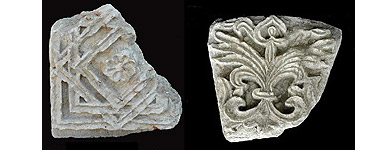
The Crusader Period (1099-1187)
"And this is the position of the city, that I could precisely understood; although this city is located in heights, in considering the nearby mountains it appears as being in the valley. To the east Mt. Olives is raising above it and on the other side, to the south, Mt. Zion which is enclosed at this time within the city walls..." Wilbrand of Oldenborg, 1212

Elbow Columns
The elbow column - a supportive architectural element - a Crusader innovation that combined two techniques which differed in their shape and usage. Its upper part served as a horizontal base perpendicular to the wall into which it was inserted, and the lower part was shaped as a column with a capital. Frequently the column was smooth with two stripes in relief, or engraved with a floral motif similar to a Corinthian capital. About seventy elbow columns have been documented in Jerusalem and its vicinity, most of them within religious institutions which are still standing.
Origin: The Citadel; The Church of Saint Mary of the Teutonic Knights.
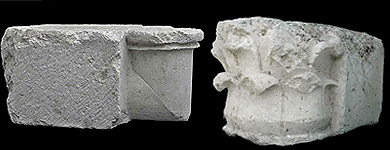
The Ottoman Period (1516-1917)
"[There] has ordered the construction of this blessed Sabil, our master the Sultan, the greater King and honorable Khaqan, who rules the necks of the nations, Sultan of the [land of] Rum, the Arabs and the non-Arabs, the glory of Islam and the Muslims, the shadow of God on earth, the protector of the two sacred sanctuaries, Sultan Suleiman, son of Sultan Selim Khan, may God perpetuate his reign and his sultanate, and make his justice and beneficence endure - on the date of the twenty-second of the month Rajab al-Murajjab (the blessed) of the months of the year nine hundred and forty-three." Sabil Bab al-Silsila. A dedication inscription, 1537

Sabil
A Sabil is a drinking installation that was integrated into Muslim buildings as a functional architectural element. They were built in Jerusalem during the Mamluk and Ottoman Periods when the authorities improved the water supply for its citizens. Sabils were located in densely populated quarters and along main roads. Ottoman architecture preserved many earlier motifs including Crusader decorations. Sabil Bab al-Silsila was erected in 1537, during the days of Sultan Suleiman 'the Magnificent' and its workmanship was superb.
Origin: The original Sabil faces the gate, west of Bab al-Silsila square.
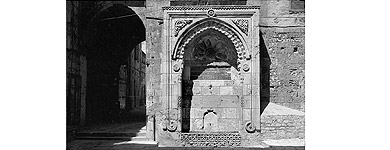
The Ottoman Pavement
This pavement was discovered in a large hall and dated to the 19th century. The hall was originally part of a larger complex that was built in the 13th century. A bakery began operating in the hall during the Ottoman period and continued until 1967. The square tiles were cut of local hard red-yellow limestone. The upper faces of the stones were polished and were carefully laid. Several of the Ottoman tiles originated in the Roman Cardo that was exposed
2 m. beneath the hall.
Origin: The northwestern area of the Western Wall plaza.
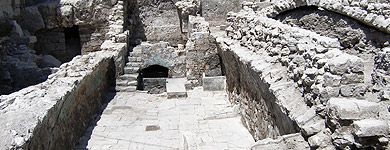
Acknowledgements:
Curator: Dr. Hava Katz, Israel Antiquities Authority
Architect: Meltzer Igra Cohen - Architects
Designer: Ronit Lombrozo
Project manager: Gad Klier
Curatorial services: National Treasures Department, Israel Antiquities Authority
Conservators: Conservation Department, Israel Antiquities Authority
בFabrication: A. Shweka & Sons, Dadoline, Dafna Galia & Vera Davidson
Excavators and Advisors:
Dr. Donald T. Ariel, Dr. David Amit, Herv? Barb?, Dr. Doron Ben-Ami, Meir Ben-Dov, Magen Broshi, Dr. Leah Di Segni, Dr. Esther Grabiner, Dr. Debbie Hershman, Fawzi Ibrahim, Prof. Benjamin Mazar, Jacques Neguer, Prof. Asher Ovadiah, Prof. Ronny Reich, Jon Seligman, Eli Shukrun, Rene Sivan, Shlomit Weksler-Bdolah, Dr. Samuel R. Wolff, Yehiel Zelinger
Photographs and Illustrations:
Adam Brown, David Eisenberg, Israel Antiquities Authority Archives, The Jerusalem Center for Near Eastern Studies (The Mormon University), Yoram Lehman, The National Library of Israel, The Palestine Exploration Fund - London, Leen Ritmeyer, Mariana Salzberger, Tatiana Slutsky-Gorenstein, Duby Tal - Albatross, The Tower of David - Museum of the History of Jerusalem, Shlomit Weksler-Bdolah